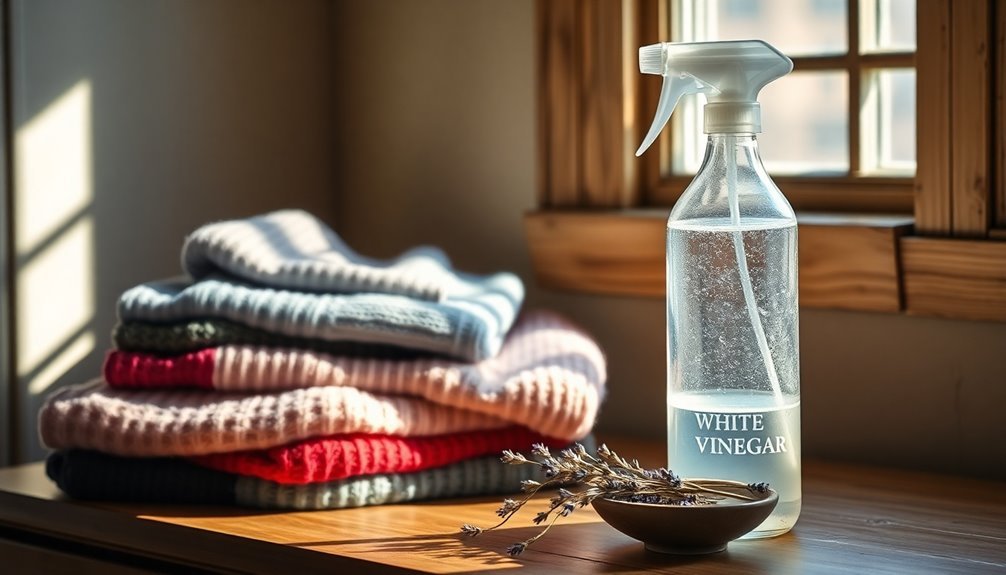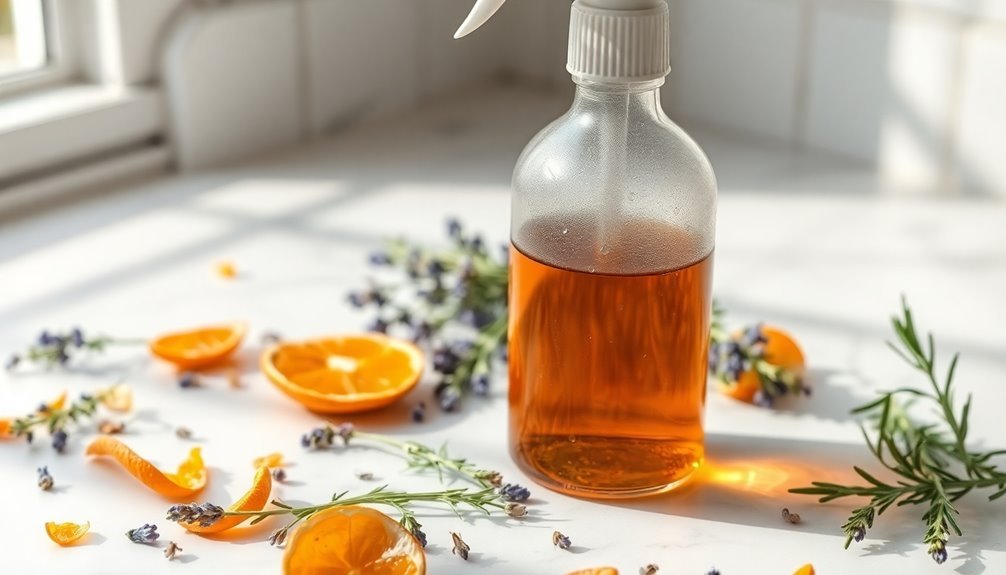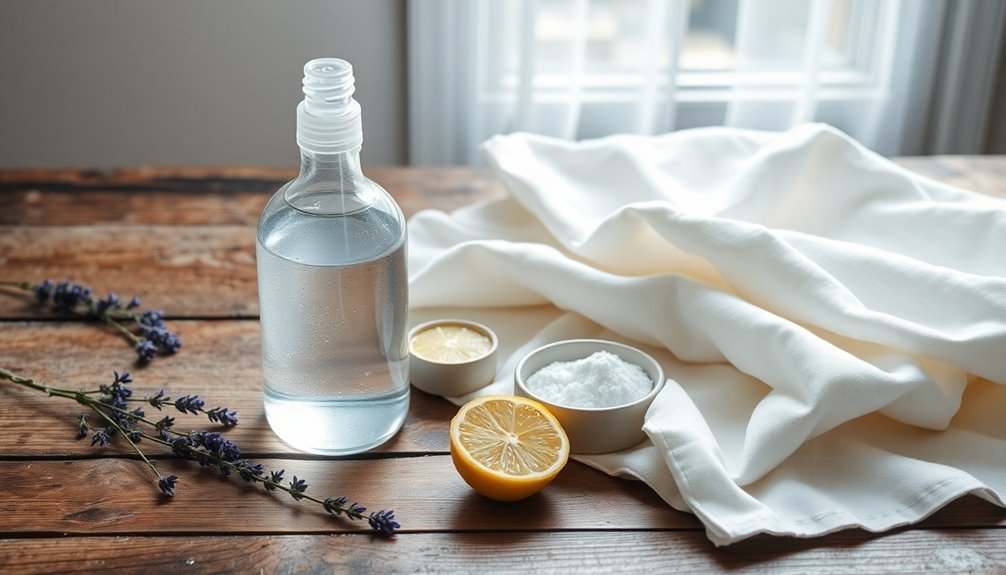Looking to eliminate static cling naturally? You'll find five proven solutions that won't harm the environment. Add 1/2 cup of white vinegar to your rinse cycle, or toss wool dryer balls into your dryer to reduce static while cutting drying time. Create a DIY anti-static spray using distilled water, witch hazel, and essential oils for a fresh scent. Roll up aluminum foil into tennis ball-sized spheres to naturally conduct and discharge static electricity. Finally, maintain ideal home humidity levels between 30-60% using natural methods like strategically placed water bowls. These eco-friendly techniques are just the beginning of your static-free journey.
The Power of Vinegar

Nearly everyone has experienced the frustrating snap of static cling in their laundry, but vinegar offers a simple and natural solution. This common household item contains acetic acid that effectively neutralizes electrical charges on your clothes while dissolving detergent residue, a major cause of static cling.
You'll find several ways to harness vinegar's anti-static powers in your laundry routine. Add a cup of white vinegar to your rinse cycle, or toss a vinegar-dampened washcloth into your dryer. Low humidity environments make static cling more likely to occur, especially during winter months. Don't worry about the smell – it'll disappear once your clothes are dry.
For a quick fix, you can even create your own anti-static spray by mixing vinegar with water in a spray bottle.
What makes vinegar particularly attractive is that it's both cost-effective and environmentally friendly compared to commercial fabric softeners. It's non-toxic, safe for your clothes, and works especially well on synthetic fabrics like polyester.
You can enhance its effectiveness by combining it with other natural solutions like wool dryer balls, soap nuts, or Epsom salts. For a pleasant scent, try adding a few drops of your favorite essential oils to your vinegar solution.
Dryer Balls and Aluminum Foil
Simplicity drives many natural anti-static solutions, and dryer balls and aluminum foil stand out as two highly effective options.
Dryer balls, typically made from New Zealand wool, work by absorbing moisture and maintaining humidity in your dryer, which naturally reduces static buildup. Cold winter months tend to produce more static electricity in laundry.
You'll find they're reusable up to 1,000 times and help cut down drying time while being completely free of harmful chemicals.
If you're looking for an even more budget-friendly option, aluminum foil balls offer remarkable static-fighting capabilities. You can make them yourself by compressing regular aluminum foil into tight balls, and they'll effectively conduct and discharge static electricity from your clothes.
At roughly 15 cents for three balls, they're incredibly cost-effective and can last for months.
While neither solution adds fragrance or fabric softening like traditional dryer sheets, they're both environmentally conscious choices.
You can maintain dryer balls' effectiveness by recharging them in hot water and drying on high heat when needed.
For aluminum foil balls, you'll simply need to replace them every few months when they start to break down.
Essential Oil Spray Remedies

Essential oil sprays regularly emerge as a versatile and natural solution for fighting static cling while infusing your laundry with delightful fragrances.
You can create your own anti-static spray by combining distilled water with witch hazel or vodka, then adding your preferred essential oils. Store your mixture in a glass spray bottle to preserve the oils' potency, and remember to shake well before each use. For best results, you'll want to adjust the number of essential oil drops to achieve your desired scent intensity.
If you'd rather not make your own, you'll find excellent commercial options like Smart Sheep Essential Oil Anti-Static Scenting Spray, available in lavender, lemon, and orange scents, or Static Schmatic's natural spray. Using 2-4 spritzes per wool dryer ball provides optimal fragrance distribution throughout your laundry.
These products work effectively on various fabrics and laundry loads while remaining eco-friendly. You're not just eliminating static – you're also avoiding harmful chemicals typically found in conventional fabric softeners.
The sprays work particularly well when used in combination with other natural anti-static methods like dryer balls.
Humidity Control at Home
Managing indoor humidity levels stands as a critical factor in preventing static electricity problems while maintaining a comfortable living environment. You'll want to maintain humidity between 30% and 60% to prevent both static buildup and mold growth. Through simple adjustments and natural methods, you can effectively control your home's moisture levels. Indoor environments with proper humidity control have been shown to significantly improve sleep quality and reduce snoring.
| Natural Humidifying Methods | Natural Dehumidifying Methods |
|---|---|
| Place bowls of water near heat sources | Use moisture-absorbing houseplants |
| Let bathwater cool naturally | Open windows for ventilation |
| Cook on stovetop without lids | Run ceiling fans continuously |
| Hang laundry indoors to dry | Place rock salt in humid areas |
| Add hydrating plants | Use natural ventilation systems |
For whole-home solutions, you can integrate humidity control with your HVAC system. If you're dealing with persistent static issues, consider installing a whole-home humidifier for consistent moisture distribution. In specific areas, portable units can effectively target problem zones. Don't forget to address moisture sources by covering crawl spaces with vapor barriers and ensuring proper clothes dryer venting. Using exhaust fans in kitchens and bathrooms helps maintain ideal humidity levels, while regular inspection and repair of water leaks prevents excess moisture buildup.
Natural Fabric Care Methods

Along with managing static electricity, proper natural fabric care plays a vital role in maintaining your clothes' longevity and reducing static cling. You'll find that each natural fiber requires specific care to perform at its best.
For cotton, you can wash in cool to warm water and dry normally, but other natural fibers need more attention. Gentle care methods help preserve natural fibers' inherent breathability and comfort properties.
When handling silk, stick to hand washing in cool water with gentle detergent, and always lay it flat to dry.
Linen and hemp share similar care requirements – wash them in cool or warm water with gentle detergent, then either air dry or use a low-heat dryer setting.
You can enhance your laundry routine with natural fabric softeners. Try mixing water, vinegar, and essential oils for an effective anti-static spray, or add soap nuts to your wash cycle in a cloth bag.
For stubborn static, combine Epsom salts and baking soda in your wash, or create a diluted hair conditioner solution.
When drying, opt for air drying when possible, as it naturally reduces static cling. If you must use a dryer, add wool dryer balls and remove items slightly damp to prevent excessive static buildup.
Frequently Asked Questions
Can Static-Preventing Methods Affect the Color Fastness of Dyed Fabrics?
Yes, your fabric's color fastness can be affected by anti-static treatments, as they may interact with dye molecules. However, when properly chosen and applied, some treatments can actually enhance dye retention and stability.
How Long Do Anti-Static Treatments Typically Last After Application?
You'll find that anti-static treatments typically last 6-9 months, but their durability varies. Internal additives last longer than external coatings, and you'll need to reapply after cleaning or in harsh conditions.
Will Natural Anti-Static Methods Work Effectively in Extremely Dry Climates?
Yes, you'll find natural anti-static methods work in dry climates, but you'll need to apply them more frequently. Using multiple approaches like humidifiers, vinegar treatments, and wool dryer balls yields the best results.
Does Water Temperature Affect the Effectiveness of Anti-Static Laundry Treatments?
You'll find water temperature doesn't directly impact anti-static treatments, but using cooler water helps preserve fabric integrity. This indirectly supports anti-static effectiveness by preventing shrinkage that could increase static cling.
Can These Methods Prevent Static Buildup in Car Seats and Furniture?
Yes, you'll effectively reduce static in car seats and furniture by using natural fiber covers, maintaining proper humidity, applying anti-static sprays, and regularly cleaning surfaces. These methods prevent charge buildup from occurring.
In Summary
You'll find these natural anti-static solutions are both effective and eco-friendly alternatives to chemical-laden products. Whether you're using vinegar in your laundry, tossing wool dryer balls into your dryer, or creating your own essential oil spray, you've got multiple options to combat static cling. By maintaining proper humidity levels and choosing natural fabric care methods, you'll keep static electricity under control while staying chemical-free.





Leave a Reply